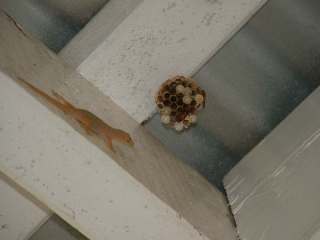
Asian Geckos & Wasps 2004
Location
These notes apply to my house in the suburb of Toowong which a western suburb of Brisbane in SE Queensland. My house is a built of weatherboard. The Asian House geckos were first noticed here about 2001. The population in and about this house is now counted in tens.
Ant Activity
About the 20th February 2004 there was persistent ant activity on our side verandah. Each day there were the front parts of one or two wasps on the floor. This kept the ants busy but the food supply did not seem to reduce.
Wasp Nest & Attendant Gecko
The source of the wasps was obvious. There was a small, new nest of the paper wasp Polistes spp. on a roof batten near a joist. The killer, an Asian house gecko hemidactylus frenatus, was not so obvious since it moved from one vantage point to another.

After dark the animal sits so that it is within 30 mm of the nest surface. During the day the gecko may be on the roof iron, on the batten or on the joist but always within about 200 mm of the nest.
Gecko, at night gecko, daytime
It is fairly obvious that the gecko is preying on the adult wasps as they emerge. On every early observation there were two wasps standing on the nest. The number of capped cells, i.e. containing pupae, varies but is decreasing with time. First there were 10 capped cells then 6 in a period of less than 24 hours.
The gecko moves only rarely but has never been seen to strike. It just stays poised for action. A wasp has been seen to move towards a gecko which, not surprisingly, jumped back.
Old Dead Wasp Nest
On the same verandah is a large nest which was started a few years ago and became inactive in one season. Near the old nest is a new one. It will be interesting to see if our gecko moves to it when the current food supply is consumed
Diary
February
on and prior 24/2/04 Front half of wasps seen on verandah on several days.
Start photos – no remains on floor
More photos – no remains on floor
Two wasps 6 capped cells -no remains on floor
One wasp -6 capped cells -no remains on floor. Ant activity near active nest. Geckos not in sight.
One wasp 6 capped cells -no remains on floor – two geckos nearby in morning
March
In morning two geckos attending. Wasp on floor with much of abdomen missing or squashed, still moving. Wings not fully extended, probably freshly hatched. Evening grub (larva) on floor, ants, no geckos. One wasp.
Two geckos seen occasionally, not in constant attendance. About 5pm copulating below nest. Now 5 capped cells. One wasp.
Two geckos seen occasionally, not in constant attendance. One wasp.
One gecko seen occasionally, one wasp
Ditto. Two capped cells
Gecko seen occasionally. Dead wasp on ground about 7pm. No transfer of activity to other nest although wasps somnolent.
No geckos, no wasps, no capped cells
No geckos, no capped cells. One wasp on nest.
13. Nest damaged, no geckos, no wasps. Wasp larva on floor.
15 & 16th Nest being destroyed, apparently consumed as no debris on verandah.
17 Nest a ruin, still no debris.
Ruined nest 19th The nest was reduced to a stump. Eventually totally consumed.
Another nest on the verandah remains active with about 20 wasps. There is a stump of yet another nest which may have suffered the same fate.
A very large, inactive, nest remains undamaged.
Compost Bin
My compost bin (lidded, cylindrical, black platic type) normally harbours one or more large spiders, usually Wolf spiders Pardosa serrata. During May I noticed that there were no spiders in the bin; there was an Asian gecko. By the middle of June there were neither geckos or spiders in the bin. The gecko population in the house disappeared in the same period. In the first week of July there was a full sized Wolf spider and no geckos.
Conclusion
The Asian house gecko will prey on or displace Australian fauna in sheltered locations. No predation in open locations has yet been seen. The lack of attack on a nearby, thriving, sheltered wasp nest indicates opportunistic behaviour.
